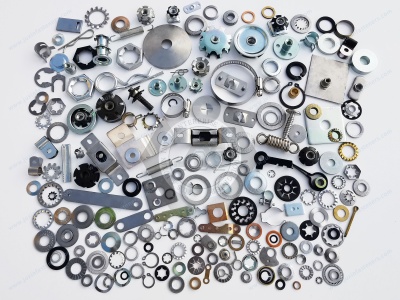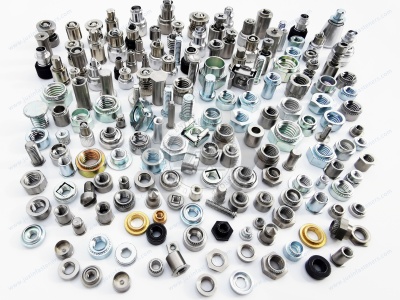Call Us
+86 136 6007 9809
Call Us
+86 136 6007 9809
Jun. 20, 2024
Materials and Manufacturing Processes for Automotive Fasteners
The development of automotive fastener tightening process technology and threaded fasteners is a testament to joint reliability and structural lightweight needs and is the culmination of threaded joint design, process, and material technology progress. The crux of bolt coupling precisely controls the bolt's axial clamping force. Achieving this level of precision in controlling the bolt axial force requires meticulous selection from the design of fasteners, careful friction coefficient control, and the correct use of tightening process methods, among other factors.
Most high-strength bolt steel is medium-carbon steel; medium-carbon alloy steel is used after heat treatment in the tempered state. Through heat treatment (tempering), its microstructure is tempered by martensite + carbides. After the austenite hyperfine before quenching, it is proved that its mechanical properties can be improved, compared with the traditional acceptable grain heat treatment of 42CrMo steel; when refined to less than 10um, all the mechanical properties (strength, plasticization, steeliness) are significantly improved. Improving the toughness or grain refinement for high-strength bolt steel can only partially meet the requirements. For example, in the vast majority of alloy structural steel, when the tensile strength is increased to 1200MPa after the delayed fracture, it increases the strength of the loss of value but causes greater insecurity. From a practical point of view, improving fatigue strength and life to enhance the performance of delayed fracture resistance is a vital and complex subject.
High-Strength Metric Class 10.9 Steel Hex Head Screws: Choose these Class 10.9 steel screws for high-stress applications, such as valves, pumps, motors, and automotive suspension systems. They are at least 25% stronger than medium-strength steel screws. Dimensions meet ISO (formerly DIN) or DIN specifications. Length is measured from under the head.
Steel screws should be used in dry, noncorrosive environments. Zinc yellow-chromate plated and zinc-plated steel screws resist corrosion in wet environments. Blue-dyed screws are easy to distinguish. Black corrosion-resistant coated steel screws resist chemicals and withstand 1,000 hours of salt spray. To maintain corrosion resistance, use these screws with black ultra-corrosion-resistant-coated nuts and washers.
Match the thread spacing of mating components. Coarse threads are the industry standard; choose these screws if you don't know the pitch. Fine and extra-fine threads are closely spaced to prevent loosening from vibration; the finer the thread, the better the resistance.
Medium-Strength SAE Grade 5 Steel Square Head Screws: Made from Grade 5 steel, these screws are suitable for fastening most machinery and equipment. Large flat sides make them easy to grip with a wrench and keep them from rotating in square holes. A zinc yellow-chromate plating provides corrosion resistance in wet environments. Grade 5 steel square head screws are marked with three radial lines. The material meets SAE J429 specifications for quality. Dimensions meet ASME B18.2.1 specifications. Length is measured from under the head.
For high-quality Medium-Strength SAE Grade 5 Steel Square Head Screws fasteners and professional technical support, don't hesitate to co don't us at adelajonly@gmail.com or visit our website at [Juxin Fasteners]: https://www.juxinfasteners.com.
The improvement of fatigue resistance is linked to the improvement of the cleanliness of the steel, especially the change of the size and distribution of the oxides, which is a difficult challenge for the electric furnace metallurgical process to produce this type of steel, and it requires a strong collaboration of all parties. The improvement of delayed fracture strength is related to grain refinement, steel structure, and grain boundary state. Scientific studies have shown that 42CrMoVNb ~ when the austenite grain refinement to 2um, delayed fracture is not better than the coarse grain size (4um); delayed fracture is essentially a hydrogen embrittlement phenomenon, usually develops in the form of along-crystal fracture, and thus susceptible to delayed hydrogen embrittlement fracture in use.
The strength of secondary hardening steel is 200 to 400 MPa higher than that of general tempered steel, as illustrated by the cold working of the steel. When a steel specimen is loaded to its yield limit, the load is rapidly removed. At the second loading, the strength of the steel increased significantly but exhibited a decrease in both plasticity and toughness.
In addition, through microscopic observation, the atomic lattice distribution of the cold-drawn steel was neater and more regular than that of the original, indicating the improvement of its strength properties—in the use of electric heating treatment and cyclic heat treatment for austenite-acceptable crystallization heat treatment at the same time, drawing on the role of Nb fine crystallization of foreign steel. The use of polarization in the austenite grain boundaries, through low-energy electron diffraction and grain boundary temperature calculations, proves the strengthening of the atomic phase of the grain boundaries.
Internationally, high-strength bolts at the 1300MPa level have been a benchmark for optimizing product design and improving product quality. The recent development of the new material 42CrMoVNb (ADF1) steel, used in the Iveco car and Cummins engine for 13.9 ~ 14.9 level of high-strength bolts, has surpassed the international standard of 12.9 level of bolt steel. This breakthrough in ultra-high-strength steel bolts is expected to impact the market; with significantly high production potential, treatment can design high-strength fasteners to obtain the required strength, good plasticity, toughness, low-notch sensitivity, and high flexural strength. This avoids the phenomenon of relaxation and other comprehensive mechanical properties and their performance, ensuring the quality and reliability of fasteners and improving the competitiveness of products in the market.
The heat treatment process of high-strength fasteners, especially their intrinsic quality, has a critical impact. Therefore, to produce high-quality, high-strength fasteners, there must be an advanced heat treatment process and heat treatment process control. The heat treatment process is characterized by changing the internal organization of the material so that a variety of fasteners can obtain the required performance and quality. As the heat treatment of the quality characteristics of the product is often not intuitive intrinsic quality (such as material tensile strength, sectional shrinkage, elongation, etc.), the production to ensure the quality of the heat treatment, generally through specialized instrumentation on the fasteners or with the furnace specimens for testing. Due to the limitations of the inspection sampling rate and inspection parts, the test is local or individual for each specification fastener and even each furnace fastener; it is impossible to achieve 100% of the heat treatment quality testing. All the test results can only partially reflect the heat treatment quality of the whole batch of fasteners. As heat treatment is produced by furnace batch input or continuous production, heat treatment quality problems result in incalculable losses. Strict control of the whole heat treatment production process and comprehensive quality management are significant for the heat treatment process. Heat treatment production with other production processes, as inseparable from the people, machines, materials, methods, and environment, are the main factors affecting the quality of heat treatment products, mutual influence, and mutual constraints, and ultimately determine the quality of heat treatment of fasteners.


Quality assurance measures for automotive fasteners
Processes and materials are the basis of mechanical manufacturing, for the quality and performance of the product play a vital role. Steel is the most essential material in fasteners. However, the proportion of non-ferrous metals and composite materials is increasing yearly, and the role of steel used in high-strength fasteners is irreplaceable. Through the use of advanced smelting equipment and process technology and reasonably low alloying, China's fasteners with steel have undergone significant changes so that the current high-strength fasteners can better meet the requirements of the actual use of the machinery manufacturing industry. Taking high-strength fasteners as an example, due to the continuous research on the technology related to high-strength bolt steel, especially the pursuit of upsetting and forging pre-processing process optimization as well as the best selection of various alloying elements and proportioning, various high-strength bolt steel can be developed.
Contact Us
Tel.:
+86 020 8621 0320
+86 020 3121 6067
Technical Support:
Navigation
SEND INQUIREY